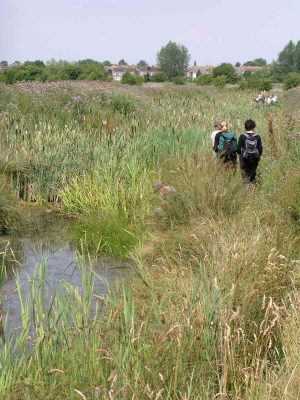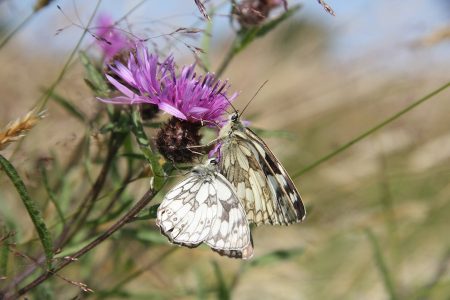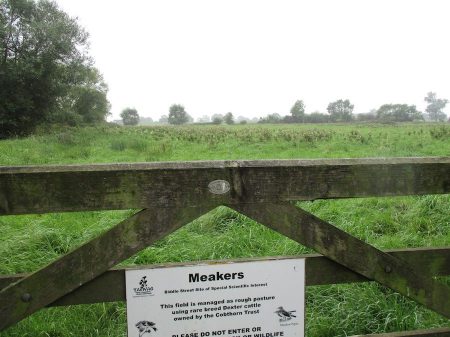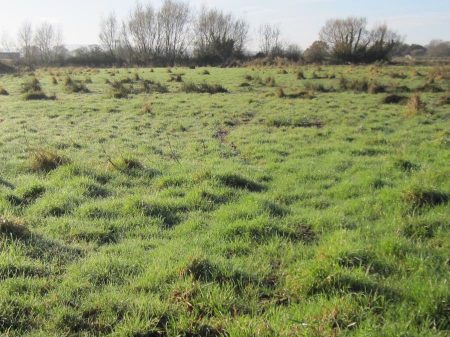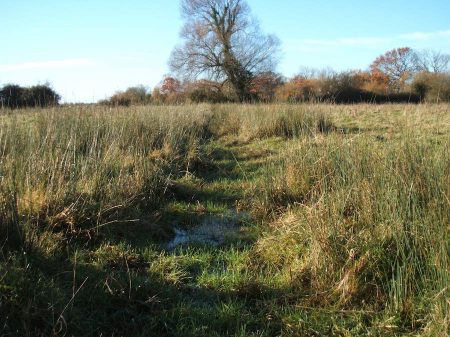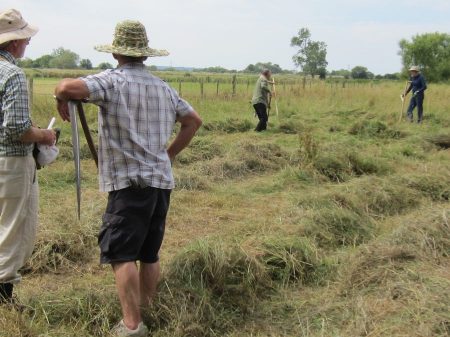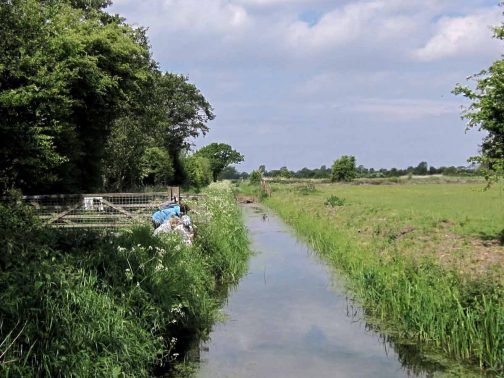
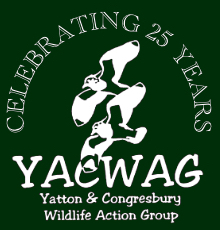
Our Reserves:
Congresbury Moor
______
Congresbury Moor Reserve comprises five fields plus a sixth, Footmead, which is just outside the historic moor, in the parish of Yatton. The five fields are: Ten Acres, New Croft, Meakers, Phippens and Nortons. Ten Acres is divided into three portions. Below you will find an overview of Congresbury Moor Reserve and detailed sections on its individual fields.
Overview
Panorama by Peter Speight © 2021
The scene above has two pulsating circles, click on these to see views from the Strawberry Line and our Nortons reserve. Alternatively, select a view using the pop-out menu on the left.
![]() = Fullscreen mode. The best way to view the panorama. Click the icon at the bottom right. Whether this works depends on the device or browser you are using.
= Fullscreen mode. The best way to view the panorama. Click the icon at the bottom right. Whether this works depends on the device or browser you are using.
Congresbury Moor is the historic name for part of the wetland known as Northmarsh that served Congresbury as common land until Enclosure in 1813 (note: the Enclosure Acts was a series of Acts of Parliament in the UK which enclosed open fields and common land in the country, creating legal property rights to land that was previously considered common). Situated south and east of the Strawberry Line the Congresbury Moor Reserve now lies within the Biddle Street Site of Scientific Interest (SSSI).
Most of its fields are managed as "rough grassland" with a non-intensive level of cutting and grazing. There are some wetland wild flowers like fleabane and cuckoo flower, as well as moorland birds like snipe and stonechat and, due to the high numbers of small mammals, kestrels and barn owls also breed here. Otters pass through and Roe deer can sometimes be observed from the Strawberry Line, which gives a good view over the Ten Acre field.
Ten Acres
Ten Acres was the first of YACWAG’s land purchases in 1999.
A large blind ditch was constructed to provide wetland habitat. This is known as the Wiggly Ditch.
GRID REFERENCE: ST 427645
SIZE: 4.09 ha
One large field divided into three compartments of approximately equal size.
PREVIOUS OWNER: Malcolm Cooke of Rectory Farm Yatton
WHEN PURCHASED: October 1999
PURCHASE PRICE: £24,900
HOW FUNDED:
Heritage Lottery Fund
YANSEC: Wessex Watermark Gold Award
HABITAT CREATION: English Nature
SPECIAL WILDLIFE:
Kestrel, barn owl, snipe in winter, roe deer, harvest mice.
Pole boxes for kestrels and owls were erected in 2001/2 and replaced in 2011/12
PUBLIC ACCESS:
Ten Acres is conveniently situated so barn owls and kestrels feeding on the mammals in the field can be seen from the Strawberry Line. Physical access to Ten Acres is available through open days, or if you would like to visit at another time, e.g. for research purposes, please contact us.
Further information
Two in depth articles written by Faith and Tony Moulin. The first appeared in "Nature in Avon" in 2002 (Volume 62. copyright @Bristol Naturalists’ Society) and covers the formation of YACWAG and it's first land acquisition, a ten-acre field. A follow up shorter piece written almost two decades later covers some of the changes the site has seen, detailing wildlife numbers, and further land acquisition.
New Croft
New Croft, the next field to the west of Ten Acres, is a traditional hay meadow, enclosed from the moor in the seventeenth century. (Note: "Croft" means enclosure). It has meadow plants like pepper saxifrage, wild carrot and knapweed. Wide margins are left uncut to allow homes for voles and invertebrates but the centre of the field is cut for hay annually.
GRID REFERENCE: ST 428646
SIZE: 1.81 ha
PREVIOUS OWNER: Mary Meaker
WHEN PURCHASED: October 2000
PURCHASE PRICE: £17,500 with another small fields - Meakers
HOW FUNDED:
Heritage Lottery Fund
YANSEC: Wessex Watermark
SPECIAL WILDLIFE:
Hay meadow flowers such as knapweed, pepper saxifrage, greater birdsfoot trefoil, meadowsweet. Insects like 6 spot burnet moths, marbled white butterflies.
PUBLIC ACCESS:
New Croft is visited in the summer to survey the invertebrates and wild flowers there. If you would be interested in joining a group to look around please get in touch. Otherwise the field is left undisturbed for nature, apart from Open Days.
2 Black Poplar cuttings were planted winter 2001/2
Two public traditional hay-cutting events with vintage machinery were held in New Croft July 2002, July 2003
Meakers
Meakers is a small field named after Mrs Mary Meaker who sold it to YACWAG along with New Croft.
GRID REFERENCE: ST 428643
SIZE: 0.98 ha
PREVIOUS OWNER: Mary Meaker
WHEN PURCHASED: October 2000
PURCHASE PRICE: £17,500 with New Croft
HOW FUNDED:
Heritage Lottery Fund
YANSEC: Wessex Watermark
SPECIAL WILDLIFE:
In and near the ditch – tubular water dropwort, water mint, fleabane
PUBLIC ACCESS:
If you would be interested in looking around the field or carrying out wildlife surveys, please get in touch. Otherwise the field is left undisturbed for nature, apart from Open Days.
Meakers in 2011 had a creeping thistle infestation which has declined as soil fertility has decreased. YACWAG does not intend to treat it.
Pole box erected December 2004.
Phippens
Phippens is the next field to the west of Meakers – a field that YACWAG was keen to purchase to complete a block of land managed for wildlife. It is named after Bill Phippen, a Congresbury farmer who sold it to YACWAG.
GRID REFERENCE: ST 428643
SIZE: 0.63 ha
PREVIOUS OWNER: Bill Phippen
WHEN PURCHASED: November 2001
PURCHASE PRICE: £5,000
HOW FUNDED:
YANSEC
Anonymous donor
In memoriam donation Trevor Riddle
SPECIAL WILDLIFE:
Cuckoo flower in spring, reed buntings breed in a bramble patch in the field.
PUBLIC ACCESS:
If you would be interested in joining a group to look around this field, or to carry out surveys, please get in touch. Otherwise the field is left undisturbed for nature, apart from Open Days.
Pole box erected December 2004.
Footmead
Panorama by Peter Speight © 2021
![]() = Fullscreen mode. The best way to view the panorama. Click the icon at the bottom right. Whether this works depends on the device or browser you are using.
= Fullscreen mode. The best way to view the panorama. Click the icon at the bottom right. Whether this works depends on the device or browser you are using.
Footmead is an ancient field of a strange shape in the parish of Yatton next to Gangwall, a former flood defence and causeway. When purchased by YACWAG the field had been very unintensively managed.
GRID REFERENCE: ST 425650
SIZE: 1 ha
PREVIOUS OWNER: Bristol Society of Friends (since 1856)
WHEN PURCHASED: December 2007
PURCHASE PRICE: £4,000
HOW FUNDED: YACWAG funds
SPECIAL WILDLIFE:
Wetland plants like tubular water dropwort, ragged robin, yellow loosestrife, brooklime. Grass snakes.
Footmead is managed by an annual hay cut taken after mid July in order to allow plants to set seed and some invertebrates to complete their life cycles.
In 2010 after the ditches had been cleared and bare earth was created on the margins, the following plants came up.
Plants coming up on the bare earth created by the ditch works carried out late winter 2010/11:
Marsh speedwell Veronica scutellata
Lesser water parnsip Berula erecta
Tubular water dropwort - Oenanthe fistulosa (T&F moved some of these plants to the ditch edge from dry positions further into the field)
Bittersweet Solanum tuberosum
Water forgetmenot Myosotis scorpioides
Water mint Mentha aquatica
Brooklime Veronica beccabunga
Sweet vernal grass Anthoxanthum odoratum
Yorkshire fog Holcus lanatus
Oxeye daisy Leucanthemum vulgare
Ragged robin Lychnis flos-cuculi
Yellow loosestrife Lysimachia vulgaris (occasional mainly on south west side)
Celery leaved buttercup Ranunculus scleratus
Tufted vetch Vicia cracca
Meadow vetchling Lathyrus pratensis
Greater birdsfoot trefoil Lotus uliginosus
Red clover Trifolium pratense
Meadow buttercup Ranunculus acris
Creeping buttercup Ranunculus repens
Great willowherb
Square stalked St Johns wort Hypericum tetrapterum
Branched bur reed Sparganium erectum
Scentless mayweed Tripleurospermum inodorum
Oil seed rape Brassica napus (single plant)
Bog stitchwort Stellaria uliginosa ?
PUBLIC ACCESS:
The field can be overlooked with binoculars from Gangwall. Access is by appointment, or by joining a workparty or survey group. The field is left undisturbed for wildlife. YACWAG manages by a hay cut when possible and grazing by cattle and/or sheep.
Nortons
The purchase of Nortons completed our land purchases giving a block of land managed for wildlife on Congresbury Moor. This means livestock can be moved from field to field.
GRID REFERENCE: ST 429642
SIZE: 0.38 ha
PREVIOUS OWNER: Mr Jones
WHEN PURCHASED: November 2009
PURCHASE PRICE: £12,000
HOW FUNDED: YANSEC (58.3%) & YACWAG funds
SPECIAL WILDLIFE:
The field has several species of vetch. An oak tree is on the ditch edge.
PUBLIC ACCESS:
This small field can be viewed from the track that forms part of the Strawberry Line (Moor Lane). Physical access is possible through organized workparties, surveys or by contacting YACWAG. Otherwise the field is left undisturbed for nature.
In 2012 Nortons north ditch was re-dug and willows pollarded. A little owl box was put in the oak tree and pole box erected.
Location
Congresbury Moor
North Somerset
Bristol
Note: the various fields mentioned above are all in this vicinity
© Copyright YACWAG, or original authors. All rights reserved. | Registered charity 1076362 | Privacy policy | Cookie policy | Terms & Conditions |Web design: StanfordGraphics
